Review Canon - Eos Rebel Sl2 Dslr Camera With Ef-s 18-55mm Is Stm Lens - White
Canon EF-S 35mm f/2.8 Macro IS STM Lens Review

The EF-S 35mm f/2.8 Macro IS STM Lens hits the streets equally Catechism's widest angle, smallest, lightest and least expensive APS-C-format (the EF-S part of the name) macro lens. While there are many very strong advantages listed in that single sentence, the product name reveals even more than, including the IS arrangement (a Hybrid-type especially well-suited to macro photography) and the STM AF arrangement, providing fast-yet-smoothen autofocusing.
Canon refers to this type of lens as a +1 lens, meaning that most volition non choose the EF-S 35 macro as their sole general purpose lens, but volition add it to their kits for the additional functionality information technology provides. While some may notice this lens adequately covers their general purpose needs, information technology definitely fulfills its promise to exist a very nice boosted lens to have in the kit.

Focal Length
When considering the addition of a lens to the kit, the focal length is an important characteristic to consider. The focal length determines the bending of view and the angle of view in turn determines the perspective provided for the desired subject framing.
As an "EF-Due south" lens, this model is just compatible with APS-C format Canon EOS Cameras (such as the Insubordinate, ***D, **D and 7D-series models) and these cameras characteristic a 1.6x FOVCF. That means that the 35mm focal length provides an angle of view equivalent to that of a 56mm lens on a full frame/35mm body. This angle of view provides a very natural perspective, approximating how we perceive a scene with our own optics and it also provides a very strong general purpose usefulness.
The 35mm APS-C angle of view will oft notice application in manner, portraiture, weddings, parties, events, documentary, lifestyle, sports, architecture, artwork, landscape, full general studio photography, pets, cars, around-the-house needs and much more. A number of the uses for this lens include people as subjects, but note that this focal length is modestly too wide bending for tightly framed head shot portraits (for my taste). The APS-C 35mm angle of view is very nice for less-tightly-framed caput and shoulders, partial body and total trunk portraits.
A lens with this focal length can be simply left mounted on the camera for whatever opportunities ascend. I ordinarily contain a lens that I'm testing into my daily use and this focal length works well for many of the uses I encounter regularly.
As mentioned in the get-go of the review, the Catechism EF-Southward 35mm f/two.8 Macro IS STM Lens is the widest angle EF-S macro lens available. That this focal length is and so broad limits the close-up capabilities to those subjects that are not scared away by the close proximity of the lens. While I would adopt a long focal length for most macro needs, primarily for the longer working altitude and stronger background blur capabilities, the wider angle choice has some advantages with the unlike/closer perspective information technology provides and the potentially more-in-focus background it creates.
Regardless of the focal length, that this lens has macro/close-up capabilities vastly extends its 35mm usefulness, with nutrient, tiny products, rings, flowers and a wide range of additional subjects easily covered.
To illustrate how useful this lens was, I felt the demand to spend some quality time with information technology around the house. I didn't have to go across the confines of the one thousand to find an afternoon of entertainment and had to force myself to let go of the farther opportunities available to me so I could get the review completed.
Most insects would too prefer you to accept a longer focal length, allowing y'all to keep a longer distance from them, only ... some exercise not mind the 35mm choice.

You probable do not desire this lens if you are pursuing the iv-legged kind of tigers, and you probably practise non have them in your back k. Simply, you may accept tiger lilies and tiger lilies attract tiger swallowtails. Either type of tiger provides a great splash of color making them very attractive subjects. Better withal are the 2 combined.

All kinds of flowers are fantabulous 35mm macro subjects and they concenter other desirable subjects.

Spiders besides enjoy the insect attracted to the flowers. While not everyone finds spiders bonny, macro altitude images making a spider's numerous eyes visible can be highly entertaining.

Non certain what to do with all of the artwork your kids (or grandkids create)? Photograph it. Then you can mentally rest every bit y'all file the precious work of art, either in the long-term storage archive box or in the circular file. Either fashion, you will appreciate having the memories saved for easy viewing at a later time. Every bit the artwork improves, this lens remains ready to capture its impressiveness.

While the 35mm APS-C focal length is a bit long for photographing the milky-way without a tracking mount (a very high ISO setting is required to avoid star trails), I even made it work for that purpose.

The vivid cloud is courtesy of a commodities of lightning, a completely unexpected, but welcomed, effect that showed up in my image.
OK, plenty distractions – dorsum to the gear review.

Max Discontinuity
Many first-time APS-C DSLR photographic camera buyers cull the optional kit lens when purchasing their camera. While the APS-C kit lenses are typically value-priced (at least when purchased in a kit) and they work OK, they are generally lacking in some areas to reach the low cost. One characteristic they always lack is a wide aperture with f/iv.5 being the typical max discontinuity at the 35mm focal length we are talking about in this review. Gaining a wider discontinuity is a bully reason for acquiring a plus-one lens.
With a 1 1/iii cease wider max aperture advantage, the 35mm f/ii.eight Macro IS STM Lens can stop activity in less than one half as much light and it permits handholding in similarly-lower light levels. In addition to allowing more light to reach the sensor, permitting faster shutter speeds and/or lower ISO settings, increasing the aperture opening permits a stronger, amend subject-isolating background mistiness at this focal length.
Here is a walk-through of most of the full-stop apertures constitute in this lens.

Here is some other paradigm illustrating the groundwork blur this lens is capable of.

With the bee not being close to minimum focus distance (MFD), there is much more blur waiting to be created.
Lenses with an opening wider than a specific aperture (ordinarily f/2.eight) enable the higher precision AF capabilities (virtually often the middle AF signal) in some cameras and nowadays a bright viewfinder image.

Image Stabilization
While the f/ii.8 discontinuity alone is dainty for low low-cal use, greatly aiding this lens' handheld low light performance (and overall versatility) is a 4-stop-rated Hybrid Image Stabilization system. To go a 4-cease do good from an equivalently wider aperture would require an unavailable-anywhere f/0.7 lens.
When you demand/want to get out the tripod behind, IS is there for y'all. Perhaps nigh important is that IS allows handholding of the camera in extremely low calorie-free situations with nevertheless subjects (or permits motion blurring of subjects such as flowing water with sharp surround). Also valuable is that IS allows handholding in medium and low calorie-free levels when more depth of field is needed, allowing narrower apertures to be used without a tripod. When using a circular polarizer filter with narrow apertures (typical for landscapes and cityscapes), IS can be helpful even under a full sun.
I find prototype stabilization especially useful when photographing macro subjects due to the stabilized viewfinder aiding in optimal composition. The "Hybrid" role of this IS system indicates that the stabilization accounts for lateral motion, especially important when photographing very close subjects.
In testing the handholdability of this lens for me personally, I found that most all results were sharp down to ane/6 second when using the 24MP Insubordinate SL2. Improve than 50% of the images were usable at .3 seconds with the keeper rate declining apace beyond this duration. This testing was done under ideal weather – I couldn't produce the same results on unstable basis in the air current for case.
This IS implementation is extremely tranquillity (virtually silent) and is quite useful for movie recording. The viewfinder remains steady at startup, shutdown and during employ with drifting of subject area framing being a not-issue.
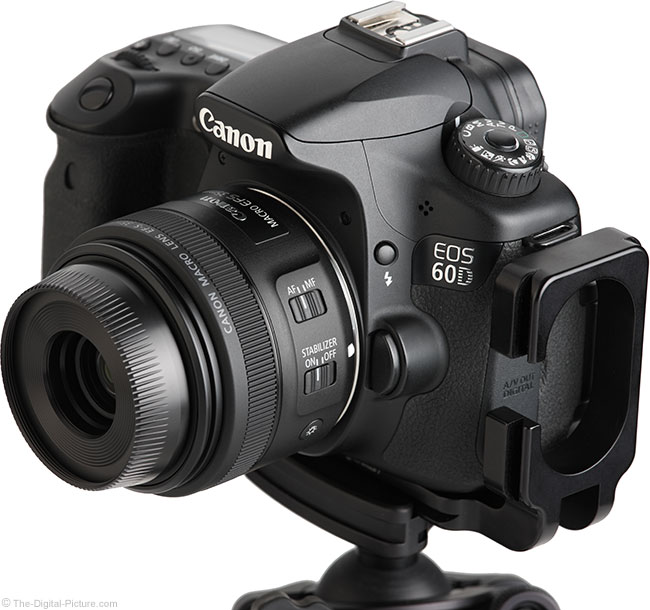
Image Quality
Co-ordinate to all marketing departments, every lens introduced is totally amazing and this 1 is promised to exist the same: "The new Canon EF-S 35mm f/ii.8 Macro IS STM captures stunning images ..." [Canon USA press release]. I suppose that nosotros should expect naught unlike every bit that blazon of promotion is what this department is hired to produce – hyping products is what they exercise and who is going to say that a production is anything just groovy? Still, I expected that they may be correct in this case. Canon's similar small wide bending prime lenses perform very well and I was not going to be surprised to run into a echo performance from this one.
With the lens in mitt, nosotros of course immediately set out to answer the "How sharp is the Canon EF-S 35mm f/2.8 Macro IS STM Lens?" question.
Broad open at f/ii.8, the EF-S 35 macro has skilful sharpness across the frame. Stop down to f/4 and the results from this lens become very sharp throughout much of the image circle with centre-of-the-frame functioning becoming especially impressive. Corners amend a chip more at f/v.6 and look very good at this point. You volition non probable be able to find any improvements at f/viii.
Let's take a expect at some outdoor examples. These images were captured in RAW format with a Rebel SL2 and candy in DPP using the Standard Picture Manner with sharpness fix to "i". These near-center of the frame crops show 100% resolution.

Notice that the foreground bud in the lower right of the offset comparing does non show much sharpness improvement at narrower apertures while the same is not true of some of the background details, indicating some focus shift occurring. While this lens shifts the centre of depth of field rearward as the discontinuity narrows, subjects stay comfortably within the overall depth of field.
The first example below takes us to the extreme lesser-right corner of the frame, followed by examples from the extreme bottom left.

If nosotros look past the concealment effects of peripheral shading hither, we see that f/2.8 is delivering good detail into the extreme corner of the frame. The f/four result looks meliorate, but by and large because of the reduced vignetting. At f/5.half dozen, the corners look quite good even for a lens costing much more than this ane.
While APS-C sensor format cameras accept a stiff peripheral shading advantage over their full frame counterparts when compared to using the same full frame compatible lens, the advantage is much reduced when using lenses designed to comprehend only the smaller image circumvolve needed by this format. In this case, a not-overly-stiff about-two stops of shading is seen in the extreme corners at f/two.eight. Stopping down from the wide open up discontinuity e'er results in comeback in this regard and in this case, 1 stop narrower (f/iv) gets us an nigh-1.iii stop improvement with a seldom-noticed .7 stops of shading remaining. Stop downward another finish (f/v.half dozen) and vignetting is a negligible about-.ii stops and about 1/two that corporeality remains at f/8. Overall, this lens performs very impressively in this regard. Even clear blue sky panoramas captured with this lens should provide for easy stitching with no sky slope issues.
Lateral (or transverse) CA, shows every bit dissimilar colors of the spectrum being magnified differently with the mid and particularly the periphery of the image circumvolve showing color fringing forth lines of strong contrast running tangential (meridional, right angles to radii) as this is where the greatest departure in the magnification of wavelengths exists. While lateral CA is easily software corrected (often in the camera) past radially shifting the colors to coincide, better is not having this outcome in the starting time identify and this lens shows just a minor amount.

Any color other than white and blackness showing in the paradigm above can be blamed on lateral CA. And once again, in that location is only a minor amount of this defect showing.
Some other relatively common lens abnormality is centric (longitudinal, bokeh) CA, which causes non-coinciding focal planes of the various wavelengths of calorie-free, or more simply, different colors of light are focused to different depths. Spherical abnormality along with spherochromatism, or a alter in the corporeality of spherical aberration with respect to color (looks quite similar to axial chromatic abnormality, merely is hazier) are other common lens aberrations to look for. Axial CA remains at least somewhat persistent when stopping down with the color misalignment consequence increasing with defocusing while the spherical aberration colour halo shows lilliputian size change equally the lens is defocused and stopping downwards one to two stops by and large removes this aberration.
In the existent world, lens defects do not exist in isolation with spherical aberration and spherochromatism generally plant, at least to some degree, forth with axial CA. These combine to create a less sharp, hazy-appearing image quality at the widest apertures. Expect at the fringing colour of the specular highlights in the foreground vs. the background in the following examples.

At f/2.8, the foreground highlight blurs take a magenta border while the groundwork highlight blurs have a cyan border. By f/4, the undesired colors have mostly left the epitome and the results wait cracking at f/5.6. While these effects are often unnoticeable, they do show upward in images at times with the "Example" showing another situation where the effect showed at f/2.8. The butterfly's legs are black-simply.
With a very depression lenses/groups count of 10/6 along with the latest optical designs and manufacturing technologies existence used, it could exist predicted that this lens would prove a very depression amount of flare and that expectation has been met. Even with greatest natural flare source available, the sun, positioned into the corner of the frame and the aperture stopped downward to f/sixteen (narrow apertures typically create the strongest flare), this lens shows only very faint flare effects.
As mentioned earlier, this focal length volition be slightly long for its f/2.eight max aperture when photographing stars (avoiding star trails and high ISO racket at bright-enough exposures without a tracking mount is the outcome), but I like what photographs of stars show me most a lens. Specially interesting is to run across how strong the effects of coma, astigmatism, etc. are in the corners. With a toward-the-north-star camera angle, this is what the near-top-correct of the frame looks like (the extreme top right was cropped off due to lack of bright stars).

The brightest star in the upper-right corner has a triangular shape, only the smaller stars are not looking bad.
With simply one focal length to be concerned virtually, prime number lens designers can unremarkably deliver a very depression geometric baloney contour and that is what we detect with the Canon EF-Due south 35mm f/2.8 Macro IS STM Lens. Low distortion, simply not perfect. The EF-S 35 shows some small barrel distortion every bit seen in this comparison with near-perfection. Interesting is that at macro distances, this lens' geometric baloney profile changes with some pincushion distortion showing as seen beneath at minimum focus distance.

While pop prototype processing programs feature lens correction profiles for most lenses which mitigates the upshot, baloney correction is destructive at the pixel level and this technique is seldom every bit proficient as capturing the paradigm using a lens that is distortion-complimentary. That said, the baloney correction profile for this lens must account for focus distance and that is a complication. Unless there are directly lines running very close to and parallel to frame borders every bit seen in the instance above, this amount of baloney will not exist noticed.
Evidently, this lens can create a very stiff background mistiness – at least when used at a curt focus altitude. The quality of that blur, referred to equally bokeh, is good. Here are some f/8.0 100% crop examples showing out-of-focus specular highlights.

While some concentric rings can be seen around the borders of blurred specular highlights (very normal), the outer transition is smoothen and the centers are quite smooth. As seen in the 2d instance to a higher place, minor round artifacts testify within the result in a low percent of the blurred highlights.
With an odd-numbered discontinuity blade count, distant signal light sources captured with this 7-bladed lens using a narrow discontinuity will become 14-indicate stars.

This lens creates a rather-strong star size, an attribute I mostly adopt.
While this lens does not get perfect scores for all image quality attributes, it performs well overall. I'll talk about value beneath, but this lens' prototype quality to price ratio is quite high.
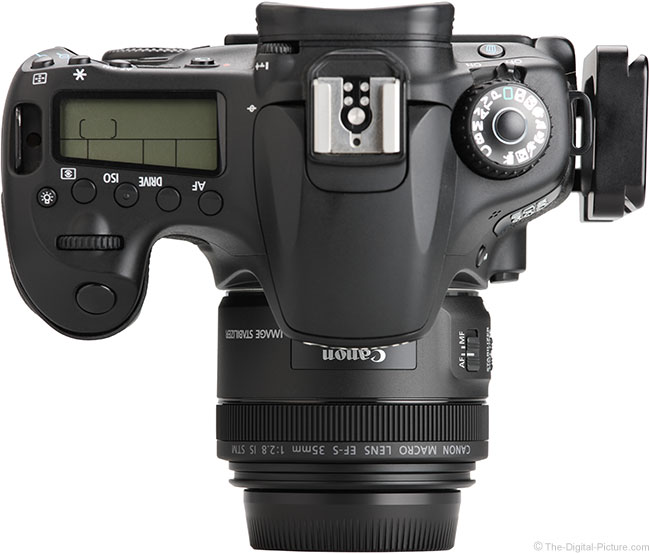
Focusing
The Canon EF-S 35mm f/two.8 Macro IS STM Lens is the start macro lens to receive the Lead-Spiral STM (Stepping Motor) driven AF system. Based on previous STM implementations, I expected this lens to focus with proficient speed and to do so very quietly. And, information technology readily meets those expectations. It is difficult to hear the lens elements/groups shuffling during autofocusing and subjects come into focus quickly.
Virtually of Canon'due south STM lenses are internal focusing and this one is the same. This is specially dainty for a macro lens as the brusque working distance at minimum focus distance is not further impeded upon by lens extension.
Canon STM lenses are well-regarded for their focus accuracy and this one performs consistently well on the Canon EOS 7D Mark 2, EOS 60D and Rebel SL2 bodies we tested it with.
STM utilizes a focus-by-wire, electrical manual focus design (vs. a direct gear-driven system). The transmission focus ring electronically controls the focus of the lens. FTM (Full Fourth dimension Transmission) focusing is supported in AF mode with the photographic camera in 1 Shot Bulldoze Fashion, but the shutter release must be one-half-pressed for the focus ring to become active (or Live View activated). Note that FTM does not work if electronic manual focusing is disabled in the camera's menu (if this selection is present). The lens' switch must be in the "MF" position and the camera meter must be on/awake for conventional manual focusing to exist available.
With electronics driving AF, the rate of focus change caused by the focus band tin can exist electronically controlled and it can be variable, based on rotation speed. That was the case with previous STM lenses and I am non at all surprised to come across the same again in the 35 IS STM. Unfortunately, I can't say that I appreciate this attribute.
When I first used the STM-driven AF lenses, I thought that I would adjust to the variable MF bulldoze speed, but I instead find information technology increasingly frustrating. Because of the dual speed MF ring, large focus distance adjustments tin can be made very quickly while precise fine tuning is made available. But, an inconsistent focus band rotation rate alter tin testify somewhat maddening when trying to chop-chop rock the focusing ring back and forth to fine melody focusing. Using marked focus ring pulls with this lens requires a practiced rate of turn, both in setup and execution of the pull. I'd rather have a single focus ring drive rate.
Cameras featuring Hybrid or Dual Pixel CMOS AF and Movie Servo AF make video recording very like shooting fish in a barrel and the STM lenses are very well-suited for this job. Their smooth focusing makes focus distance transitions easy on the viewer'southward optics and the audio of the lens focusing is not picked upwards by the camera'due south mic. Even the STM lens' aperture changes are quiet and shine.
The EF-S 35 macro's focus ring is relatively small-scale, only it is large enough to be quite useful and manual focusing is frequently useful for macro photography. The ring requires only a very light rotational forcefulness, turning more than easily than I prefer.
Focus distance indications and depth of field marks, such as often provided in a window, have been omitted from this lens.
Subject size changes noticeably in the frame during focus adjustments. While this aspect is not unusual, photographers intending to use focus stacking techniques involving focus distance aligning, videographers pulling focus and anyone very-critically framing a scene should be aware.
When Canon includes "Macro" in the lens name, it is probably going to be the real deal and that is the instance with the Canon EF-S 35mm f/two.8 Macro IS STM Lens. Delivering a full 1.00x MM (Maximum Magnification) and 1:one RR (Reproduction Ratio), this is a true macro lens and this capability opens upwardly a whole new globe of subjects inviting capture. Here is a tabular array comparing a handful of Canon lenses:
| Model | MFD | MM | |
| Catechism EF 24mm f/two.8 IS USM Lens | 7.nine" | (200mm) | 0.23x |
| Canon EF-Due south 24mm f/two.8 STM Lens | six.3" | (160mm) | 0.27x |
| Canon EF 28mm f/2.8 IS USM Lens | 9.1" | (230mm) | 0.23x |
| Catechism EF 35mm f/2 IS USM Lens | nine.iv" | (240mm) | 0.24x |
| Canon EF-Southward 35mm f/2.8 Macro IS STM Lens | 5.1" | (130mm) | 1.00x |
| Canon EF 40mm f/ii.8 STM Lens | xi.8" | (300mm) | 0.18x |
| Catechism EF 50mm f/1.eight STM Lens | 13.viii" | (350mm) | 0.21x |
| Canon EF-South 60mm f/ii.eight Macro USM Lens | vii.9" | (200mm) | ane.00x |
| Catechism EF 100mm f/2.8L IS USM Macro Lens | 11.eight" | (300mm) | one.00x |
| Canon EF 100mm f/ii.8 USM Macro Lens | 12.two" | (310mm) | i.00x |
What does 1.00x maximum magnification and ane:1 reproduction ratio mean? Information technology means that you tin render a subject life-size on the camera'southward imaging sensor. In this example, a subject measuring only .nine x .6" (22.5 ten fifteen.0mm) will completely fill the frame. Of grade, y'all usually view images at a much larger size than this and that means your little bailiwick will be output in sizes ranging from your smartphone display up to your big desktop monitor or even a poster on the wall. And in that case, the ane.00x and 1:1 numbers don't seem to give justice to the results.

Shown above is the treasury seal from US two dollar nib. At 24 megapixels from the Rebel SL2, this small detail could be reproduced at a huge size.
Magnification from wide angle through standard/normal focal length lenses is mostly significantly increased with the utilize of extension tubes, which are basically equally their proper noun implies, hollow tubes (with electronic connections) that shift a lens farther from the camera. Doing so allows the lens to focus at closer distances, though at the expense of long distance focusing. Canon lists the MM range for the inclusion of a 12mm Extension Tube as 1.41-0.34x and ane.91-0.76x for a 25mm Extension Tube. Those are very bonny numbers, only I was very skeptical of the usefulness of these combinations.
Because this lens has an extremely short 1.18" (30mm) working distance (front of lens to subject distance) at its MFD, it was hard to visualize an extension tube behind this lens leaving a sufficient working distance at significantly increased magnifications. But, at that place is sufficient working distance remaining with fifty-fifty the 25mm extension tube in identify and with the built-in ring light, lighting that extremely close bailiwick is accomplishable.
This lens is not compatible with Catechism extenders.
Build Quality & Features
The EF-South 35mm macro lens, though unlike, bears much resemblance to the Canon EF 24mm, 28mm and 35mm IS Lenses. This lens is targeted at entry level and amateur photographers with a mid-level build quality, i similar to the above-mentioned lenses.

Like the just-mentioned lenses, the EF-S macro lens is not a atmospheric condition-sealed and intendance should be taken when wet or dust could be encountered.

Equally mentioned, the EF-South 35mm macro lens has a very curt 1.xviii" (30mm) working altitude between the terminate of the lens and the subject field at its MFD. When working distances become curt, lighting the bailiwick becomes challenging and this lens incorporates a feature that direct address this issue. This feature is a pair of continuous, round LED lights, referred to as "Macro Lites", positioned within the front rim of the lens (as first seen in the Canon EF-M 28mm f/iii.5 Macro IS STM Lens).

Check out that beautiful little lite switch showing in the prototype beneath.
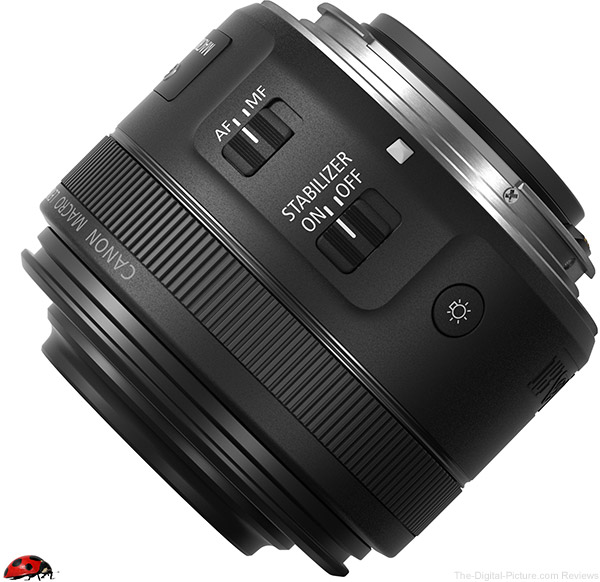
Here is a look at the lights from the objective end of the lens:

As demonstrated above, the two LEDs (A & B) are individually adjustable for full or half power (or turned off). With both lights enabled, pushing the light push turns the lights on at total power, pressing it a second time selects one-half power and the 3rd press turns the lights off again. In unmarried-light way, pressing the calorie-free switch repeatedly spins through the 4 single low-cal options and off. As well turning the lights off is the photographic camera timing out or auto-powering off (setting the photographic camera's car power off time to a longer duration is helpful in keeping the lights on for advisedly equanimous images).
To toggle between the dual and single low-cal modes, press and hold the light button for 2 seconds. The lens remembers which light style it was in prior to turning off and selects that mode if re-activated within a short menstruum of time.
Note that the lite switch is not like shooting fish in a barrel to find by touch and this has been a bit of a frustration. While the affluent push button design is bang-up for when the light is not existence utilized, I struggle to tactiley detect it. This is not an peculiarly-easily-seen location of the lens and I oft find myself pressing various locations on the barrel until I get lights-on. A elementary crash-land or like texture alter would have made this button much easier to locate.
How bright are the Catechism EF-S 35mm macro lens lights? That is a very good question. Canon does not provide the brightness spec with this lens, and that was a proficient reason to perform a test.

The elementary test I chose was to use a frame-filling grey bill of fare in complete darkness every bit a metering subject (at ISO 100). Milestone altitude measurement selections were made each time the Rebel SL2 photographic camera meter said in that location was a one-stop difference from the previous measurement. The altitude measurements are shut approximates, reporting the distance from terminate of lens to gray menu.
| Distance | Lux | f/2.8 | f/8 | iPhone Lux | |
| MFD | 1400 | ane/50 | 1/6 | 8300 | |
| ii.viii" | (vii.1cm) | 400 | 1/25 | 1/iii | 1900 |
| 4.3" | (10.9cm) | 160 | 1/13 | .vi | 840 |
| six.3" | (16.0cm) | 75 | i/half dozen | one.33 | 400 |
| 10.0" | (25.4cm) | 28 | .3 | 2.5 | 150 |
| thirteen.v" | (34.3cm) | nineteen | .half-dozen | v | 86 |
Increasing the ISO would of course increase the shutter speeds by the same number of stops. The low power setting is 1/two as bright (confirmed past the calorie-free meter). The rules of light are not changed by the band light only because it is on a lens, then go dorsum to what you know nearly light and the effulgence of the lite reaching the subject dropping off at an exponential rate.
Here is a photo of the built-in lights illuminating a white wall from a slight bending toward the wall, showing the axle spread and low-cal fall-off.

There is no question that the built-in lights are non extraordinarily bright. With the iPhone 6s providing essentially more light, it becomes obvious that the ring calorie-free is not meant to blast a subject with lite, at least not from a very long altitude (your phone tin can practice a better job at that task). The location, size, shape and convenience of the built-in LED lights are this lens' big advantages.
Let'southward go to an example. Mushrooms are very hard to photo due to lighting problems. The underside of their caps are ever much darker than their tops. The instance beneath illustrates how the built-in lights resolve this problem and besides illustrate how the power levels (with both lights on) can be adjusted to remainder with ambient light levels.

If the built-in ring light is beingness used equally the sole light source, you want to apply high power. But, a dandy fashion to utilize the built-in light is to remainder the lens' calorie-free power level with the ambient, providing the correct balance of fill low-cal to other calorie-free sources. My preference in the in a higher place comparing is the "Depression" example, using the half-ability calorie-free setting, with the underside of the mushroom brightness balanced nicely with the background brightness. The exposures used above were 1/6, f/2.8 and ISO 100. The Rebel SL2 was laying directly on the footing with a Feisol TT-15 Mini Tripod lying on its side to stabilize the camera.
An even amount of low-cal coming from both side of the lens with the lights located most on-centrality with the optical path is going to create flat lighting. A flat light is often platonic for make full, but it is non e'er ideal for master-light purposes. If you want to capture the coloration details of the subject area without the texture, use both lights on the same brightness as illustrated to the right beneath.

The ambience example above utilized side-oriented window calorie-free from a cloudy mean solar day to create shadow details in this l%-reduced crop sample (a two dollar pecker). If you want to see some texture details, the ambient might exist the better pick in this example. Or, cull to use merely one of the band lights.

By turning on only a single light, shadows tin be utilized to bear witness depth and texture.
Annotation that, as with any band light, reflective subjects are going to prove a circular ring of calorie-free when the Macro Lite is in use. This is a photograph of blackness back-painted drinking glass, which illustrates both a reflection and the nicely-even calorie-free spread showing in the lights.

Then, is the Canon EF-South 35mm f/ii.viii IS STM Lens' built-in LED ring light bright enough? The simple answer is yeah, it is adequate for shut work, peculiarly if using a tripod.
These lights are non flashes and they do non provide the level of light intensity that flashes provide, just they aid in both composition and focusing at the altitude they are useful at. With the combination of the ring lite and image stabilization, this lens can exist handheld for shut-up work in even complete darkness at ISO 100. Don't expect to use this lens' lights for your portrait work, but they are helpful and extremely convenient for shut work like flowers or jewelry (perhaps nuptials rings?) and they provide the illumination needed for limerick at close distances. As the lights are continuous, shut-upward video possibilities are promising and improved close-distance AF performance in depression light is another do good. The convenience of having a band light built into the lens is really high.
Interesting is that the rim aft of the born Macro Lite is designed to mount Catechism's far more than powerful macro flashes. No adapter is needed for the MR-14EX II to be attached to this lens. Having a double band low-cal is ... amusing. An interesting reward of the built-in band calorie-free over the powerful accompaniment flash is that information technology is located closer to the optical path, significant it tin better-light light extremely close subjects.
This lens does not have a battery, so wait the Macro Lites to have some level of touch on on the camera'due south battery life.
This lens' lights are a terminal resort for use as a flashlight if defenseless otherwise unprepared in darkness somewhere.
A very strong asset of the Catechism EF-Southward 35mm f/two.8 Macro IS STM Lens is its pocket-size size and calorie-free weight. This is a compact, easy-to-take-with-you lens and only a very small-scale number of lenses are lighter or smaller.
| Model | Weight | Dimensions w/o Hood | Filter | Year | ||
| Catechism EF 24mm f/2.8 IS USM Lens | ix.9 oz | (280g) | 2.7 x 2.2" | (68.4 x 55.7mm) | 58mm | 2012 |
| Canon EF-S 24mm f/two.8 STM Lens | 4.four oz | (125g) | two.7 ten 0.9" | (68.2 x 22.8mm) | 52mm | 2014 |
| Catechism EF 28mm f/two.viii IS USM Lens | ix.two oz | (260g) | 2.7 x two.0" | (68.4 ten 51.5mm) | 58mm | 2012 |
| Canon EF 35mm f/2 IS USM Lens | eleven.eight oz | (335g) | three.one x ii.v" | (77.9 ten 62.6mm) | 67mm | 2012 |
| Canon EF-S 35mm f/2.8 Macro IS STM Lens | six.seven oz | (190g) | 2.7 ten 2.2" | (69.2 x 55.8mm) | 49mm | 2017 |
| Catechism EF 40mm f/2.viii STM Lens | 4.6 oz | (130g) | 2.seven x 0.nine" | (68.2 x 22.8mm) | 52mm | 2012 |
| Catechism EF 50mm f/1.viii STM Lens | 5.vi oz | (159g) | 2.7 ten 1.5" | (69.2 x 39.3mm) | 49mm | 2015 |
| Canon EF-South 60mm f/two.eight Macro USM Lens | 11.viii oz | (335g) | 2.9 10 two.eight" | (73.0 x 70.0mm) | 52mm | 2006 |
| Canon EF 100mm f/2.8L IS USM Macro Lens | 22.1 oz | (625g) | 3.i x 4.8" | (77.7 x 123.0mm) | 67mm | 2009 |
| Catechism EF 100mm f/two.8 USM Macro Lens | 21.ii oz | (600g) | three.i x 4.7" | (79 x 119mm) | 58mm | 2000 |
For many more comparisons, review the complete Canon EF-S 35mm f/2.8 Macro IS STM Lens Specifications using the site's Lens Spec tool.
Here is a look at Canon'due south latest 35mm lenses forth with the tiny 40mm pancake thrown into the comparing.
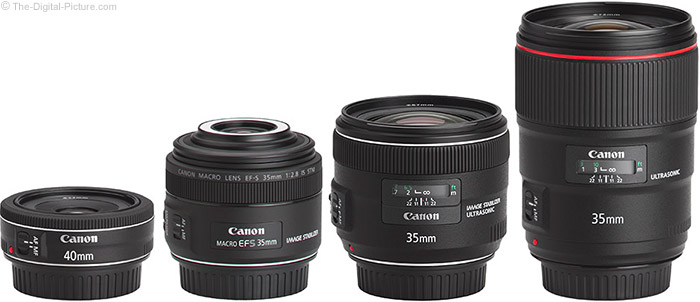
Positioned above from left to right are the following lenses:
Catechism EF 40mm f/ii.viii STM Lens
Canon EF-S 35mm f/two.eight Macro IS STM Lens
Canon EF 35mm f/two IS USM Lens
Canon EF 35mm f/1.4L Ii USM Lens
The same lenses are shown below with their hoods in identify.

For a unlike perspective, shown below are Canon's current up-to-100mm macro lenses:

Positioned above from left to correct are the following lenses:
Canon EF-South 35mm f/two.8 Macro IS STM Lens
Canon EF-S 60mm f/two.8 Macro USM Lens
Canon EF 100mm f/2.8 USM Macro Lens
Canon EF 100mm f/2.8L IS USM Macro Lens
And, the same lenses with their hoods in place.

Use the site'southward production image comparison tool to visually compare the Canon EF-South 35mm f/two.viii Macro IS STM Lens to other lenses.
Rather unique for a Canon lens is the 35 macro's 49mm filter thread size – the EF 50mm f/1.eight STM Lens is the only Canon DSLR lens sharing this filter size equally of review time. Also unique is that, with the unusual front lens design, in that location are no filter threads on the 35 macro lens. I know – you are wondering how the lens tin can have a filter thread size merely no filter threads. The respond is that the filter threads are on the lens hood.
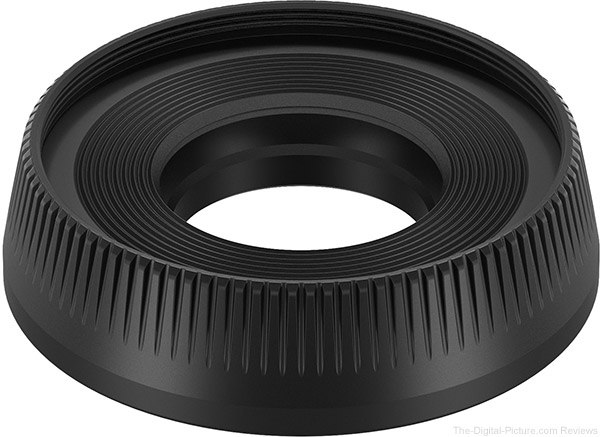
Canon historically has made lens hoods optional on all except its professional-grade lenses. I call back that lens hoods are valuable and it seems to me that they tin be produced very inexpensively, and so I recall that lens hoods should always be included and I've complained when they are not. To solve the filter zipper result for this lens, threads were incorporated into the lens hood and with the elevated importance of this hood, Canon opted to include the ES-27 Lens Hood in the box.

While not designated for a filter, the lens itself does have threads and the size is hinted-to past the lens hood proper name. The 27mm threads are provided around the end of the objective lens element, just inside lights.

The lens cap tin can mount inside the lens hood threads or information technology tin can alternatively clip onto the end of the hood. The lens hood screws into these threads
The hood is all-metal constructed and it feels very solid. The hood protects the eyes from flare-inducing lite and from impact. The ES-27 also blocks the reflection of the white lights in reflective subjects.
No case or pouch is provided in the box for this lens. Canon lists the Lens Pouch LP1014 equally their suggested solution. A pocket-sized Lowepro Lens Case would exist a more-protective choice for single lens storage, transport and behave.

Toll and Value
The Canon EF-Southward 35mm f/2.8 Macro IS STM Lens is targeted at beginner and amateur photographers and it has an accordingly-bonny price. Nonetheless, many seasoned photographers, including professionals, will recognize the appeal of this lens in their kits. This is a very useful and convenient-to-have lens that does non require income-producing usage to get in a worthwhile investment. The value suggestion of the EF-South 35mm macro lens is a high ane.
As an "EF-Southward" lens, the Canon EF-S 35mm f/two.viii Macro IS STM Lens is compatible with all Canon "EOS" cameras with an APS-C format sensor including Rebel, ***D, **D and 7D-Series models (note that the very quondam EOS 10D, D30 and D60 are not EF-S lens uniform). The EOS "K" line is also compatible via an EF-EOS M Adapter). This lens comes with a 1-twelvemonth limited warranty.
Alternatives to the Canon EF-Due south 35mm f/2.8 Macro IS STM Lens
At that place are a couple of approaches to take when considering the alternatives for this lens. The first is to compare this lens to the other macro lenses.
In Catechism's lineup, the three closest macro lens alternatives to consider are the EF-Due south 60mm f/2.8 USM Macro Lens, the EF 100mm f/2.8L IS USM Macro Lens and the Canon EF 100mm f/2.viii USM Macro Lens.
The 60mm option lacks image stabilization and is moderately larger/heavier/more expensive. The longer 60mm focal length provides more than working distance and, with similar subject field framing, it delivers a more-compressed perspective and a more-strongly blurred background (with less background in the frame). These ii lenses are at least similar in sharpness with the 35 results appearing slightly better at narrower apertures. The 60 will show flare more than easily but has less (negligible) baloney. The 60mm lens has Band USM AF vs. the STM AF system in the 35.
The 100mm macro lens options extend both positive and negative aspects of the 60mm lens option, with ane of the two lenses still defective image stabilization. The negative aspects include that the 100 macro lenses are considerably larger, heavier and more than expensive. A 100mm lens is very dissimilar from a 35mm lens, but those serious well-nigh macro photography will likely find the considerably longer focal length hands worth any size/weight/price inconvenience. If your subject can be scared away (think insects), the 100mm choice is going to exist a much better choice. The longer focal length is better at maintaining pleasing perspective for tightly framed portraits. As with the 60mm lens, the longer focal length has advantages including more working distance, a more-compressed perspective and a more-strongly blurred background (with less background in the frame), but the 100mm advantages are considerably stronger than the lx's in these regards.
From an prototype sharpness perspective, the 35mm macro lens is slightly sharper than the 100mm non-L macro lens.
The 100mm 50 IS pick includes the hybrid image stabilization feature, only similar to the 100mm non-50 lens option, this lens is over 3x heavier than the 35, is considerably larger and costs more than twice equally much as the 35. That the 35 competes strongly with the 100mm L in terms of sharpness is quite impressive.
Both of Canon's 100mm lenses will show flare more easily, merely they have less distortion and far less vignetting on APS-C format cameras (typical for a full frame lens on an APS-C camera). That the 100mm lenses are "EF" models, compatible with full frame Canon EOS camera models, means that they will migrate to the larger sensor format with you. Another differentiator is that the 100mm lenses accept Ring USM AF vs. the STM AF organization in the 35.
If because the 100mm options, you may also find the Sigma 105mm f/ii.8 EX DG OS HSM Macro Lens and Tamron 90mm f/two.8 Di VC USD Macro F017 Lens interesting.
Sometimes, the perspective provided by 35mm is preferred over a more-afar perspective required by a longer focal length for similar subject framing. The closer perspective tin can sometimes better emphasize closer subjects and pull a viewer into the frame. And, the wider bending focal length makes it easier to go on the entire frame abrupt.
While the EF-South 35mm f/two.viii is a macro lens, information technology is much more that. This lens' uses are non limited to close-upward photography and if the close-up capabilities are not profoundly important to yous, Canon and other lens makers have many options for you to consider. 2 of the nearly-similar are the Canon EF 35mm f/2 IS USM Lens and the Canon EF 40mm f/2.8 STM Lens. Both of these very popular lenses feature very good paradigm quality and both are full-frame compatible, so their larger image circles testify less vignetting at wider apertures when used on an APS-C format camera.
The highly-loved 35mm f/two IS has a one-stop (twice every bit much light) wider max aperture, shares the identical focal length and includes epitome stabilization. The f/2 lens is slightly sharper, has less distortion and has far less vignetting. This lens is modestly larger, notably heavier (largely due to the full frame 2x wider aperture), moderately more expensive and has a Ring USM-driven AF system.
The tiny 40mm f/two.eight features a pancake lens design. While this lens lacks IS, it is noticeably smaller, much lighter and considerably less expensive. Though the lens is small-scale and cheap, it performs very well and qualifies as i of the best deal lenses available. From a sharpness perspective, the 40 is close to the 35. Again, the xl has less baloney and far less vignetting. While the 40 and 35 share "STM" AF systems, the 35's organisation is noticeably quieter.
Use the site's reviews and lens comparison tools to create your ain comparisons.

Summary
It is not hard to find room in the bag for the addition of the Canon EF-S 35mm f/2.8 Macro IS STM Lens and especially with the congenital-in macro ring lite and paradigm stabilization, the 35 macro has a very high convenience-to-use gene. With its 1x/i:1 macro adequacy and great general purpose focal length, subjects abound for this lens. One of the best features of this lens is the wallet impact at checkout – light. Lite as well aptly describes the lens itself. The image quality delivered by this lens is quite good and information technology is non difficult to justify the addition of this lens to the kit.
Entry level and apprentice photographers are primarily targeted by this lens, merely the Canon EF-S 35mm f/2.8 Macro IS STM Lens, for the reasons listed above, is going to be found in many pro kits also.
Bringing yous this site is my full-fourth dimension chore (typically threescore-80 hours per week). Thus, I depend solely on the commissions received from yous using the links on this site to make any purchase. I am grateful for your back up! - Bryan
My Recommended Canon EF-Southward 35mm f/2.viii Macro IS STM Lens Retailers
Rent the Canon EF-S 35mm f/2.viii Macro IS STM Lens
The Tip Jar
More Canon EF-South 35mm f/2.8 Macro IS STM Lens Related Information
Bryan Recommends Ownership It Here
Source: https://www.the-digital-picture.com/Reviews/Canon-EF-S-35mm-f-2.8-Macro-IS-STM-Lens.aspx
0 Response to "Review Canon - Eos Rebel Sl2 Dslr Camera With Ef-s 18-55mm Is Stm Lens - White"
Post a Comment